
-
Find the right food for your petTake this quiz to see which food may be the best for your furry friend.Find the right food for your petTake this quiz to see which food may be the best for your furry friend.Featured products
 Puppy Sensitive Stomach & Skin Salmon & Brown Rice Recipe
Puppy Sensitive Stomach & Skin Salmon & Brown Rice RecipeDelicious, highly digestible recipe, gentle on stomachs. Nourishes skin & promotes a lustrous coat
Shop Now Puppy Large Breed Chicken & Brown Rice Recipe
Puppy Large Breed Chicken & Brown Rice RecipeVital nutrients to support 5 essential building blocks for lifelong health
Shop Now Adult Chicken & Barley Recipe Dog Food
Adult Chicken & Barley Recipe Dog FoodSupports lean muscle and beautiful coat for adult dogs
Shop NowFeatured products Adult 7+ Chicken Recipe Cat Food
Adult 7+ Chicken Recipe Cat FoodSupports energy level and beautiful fur in mature cats
Shop Now Kitten Chicken Recipe
Kitten Chicken RecipeVital nutrients to support 5 essential building blocks for lifelong health
Shop Now Adult Urinary Hairball Control Chicken & Rice Recipe Cat Food
Adult Urinary Hairball Control Chicken & Rice Recipe Cat FoodActively supports the health of the whole urinary system
Shop Now -
Dog
- Dog Tips & Articles
-
Health Category
- Weight
- Food & Environmental Sensitivities
- Urinary
- Digestive
- Joint
- Kidney
-
Life Stage
- Puppy Nutrition
- Adult Nutrition
- Senior Nutrition
Cat- Cat Tips & Articles
-
Health Category
- Weight
- Skin & Food Sensitivities
- Urinary
- Digestive
- Kidney
-
Life Stage
- Kitten Nutrition
- Adult Nutrition
Featured articles The Incredible Science Behind Your Pet's Microbiome
The Incredible Science Behind Your Pet's MicrobiomeLearn what a pet's microbiome is, how it contributes to your pet's gut & overall health, and why nutrition is important in maintaining healthy microbiomes.
Read More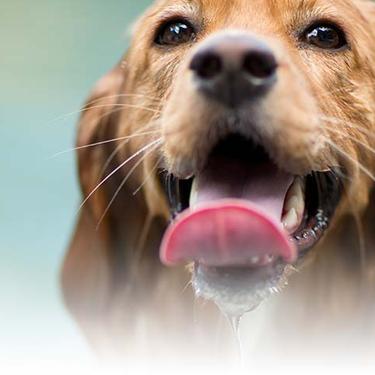 Water
WaterDiscover why water is the most important nutrient for your dog or cat to live a healthy life. Find out how much water your pet should consume each day.
Read More Pet Food Storage Tips
Pet Food Storage TipsDiscover how and where to store your dry, as well as canned, dog and cat food. Learn how to find the "best before" dates on all Hill's pet food packaging.
Read More -


Dog park trips offer dog parents and their pets a great opportunity to bond, socialize, and run off some pent-up energy, but with all that fun comes responsibility. Dog park rules and regulations are there to ensure the safety and fun of all its visitors. No matter what type of dog park you go to, knowing and following its rules will help keep you and your dog safe.
Types of Dog Parks
Most dog parks are designed for dogs to play, run, and enjoy the company of other pups. But, as described by the American Kennel Club, they should always include a fenced-in area to keep dogs safely contained while off-leash. Additional amenities usually include some form of shade (or trees for shade), benches for pet parents to rest and supervise, and water for when pups get thirsty. A pooper-scooper station, complete with empty bags and a receptacle, help keep the park neat and under control as well.
Dog parks may include leashed and off-leash areas. Leashed areas mean dogs must be kept on a leash at all times. An off-leash area affords you various spots where you can safely release your dog in an enclosed area to run or play. Larger dog parks may even separate dogs according to size, providing large-breed dogs with an area to play without intimidating or harming smaller dogs.
Rules of the Outing
Each city or town establishes its own rules for the local dog park. These rules are usually displayed on the fence or gate of the dog park, and should be followed at all times. If you do not see these rules posted at the entrance, it might be wise to perform an online search for the dog park you are visiting to see if the city website has any special rules listed. According to DogPark.com, the most common dog park rules include the following:
Pet parents are responsible for their animals. Take responsibility for your dogs' behavior at all times. Make sure he's properly socialized and non-aggressive toward strangers and the dogs they're playing with.
- Pick up after him. If your dog does his business, be prepared to scoop, bag, and dispose of his waste properly. Leaving messes isn't just unsightly, it's unsanitary.
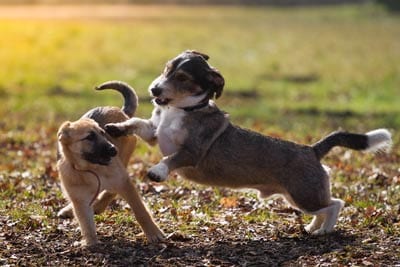
- Make sure he's vaccinated. All dogs visiting the dog park must be up to date on vaccinations.
- Dogs in heat should be left home. Do not bring a female dog in heat to the dog park; her presence can create fights and distractions for the other dogs.
- Don't bring food into the park. Leave your picnic lunch outside. Other dogs may not have good manners around people enjoying a meal, and can act aggressively toward you if they pick up the scent of the food you're eating. If your dog does his business or performs a command and usually gets a treat for it be sure to give him verbal praise and a good pet to reassure him that he still did a good job to reinforce the good behavior. Dog treats aren't the only special reward dogs are seeking from their pet parents.
- No little kids. Infants and toddlers can be easily knocked over by overly rambunctious dogs. Strange dogs may be unfamiliar with kids, putting children at risk for bad experiences or injuries that leave the parent responsible.
- Keep your leash with you. Even in off-leash parks, keep your dog's leash with you at all times. You may need to quickly remove your dog from an unpleasant or aggressive dog visiting the park.
- While you can bring your own dog toys like tennis balls or Frisbees®, make sure that no other dogs will be competing for them. Much like toddlers, untrained dogs can throw a bit of a tantrum if they have to share their favorite toy.
- Always have a collar on your dog. While it is recommended to keep a collar on your dog at all times anyways and dog parks are enclosed areas, there is still the chance of your dog racing for the exit. You can help keep him safe by being sure he always has his collar with up-to-date tags on.
Interacting with Other Dogs
One of the benefits of taking your dog to the dog park is to let him interact and play with other dogs. While this is a fun and exciting treat for you and him both, it is important to exercise certain cautions to ensure that all dogs and dog parents are safe. Before letting your dog play with any other dogs it is important to meet the parent of the other dog. Ask them about their furry little friend to see if it is okay for the two dogs to play. Not all dogs get along with other dogs, or they might be a bit too rough with dogs of a certain size. Also, some pet parents may just be looking for an outing to share alone with their pooch and aren't looking for a play date at this time; be sure to respect their wishes as there are probably plenty of other dogs and parents that are willing to let the two dogs become the best of pals.
When introducing two dogs it is usually a good idea to keep them both on a leash and let them sniff each other. This will allow you to control his movements if some roughness starts to break out. If a fight does start to break out, never get in the middle of it as it can lead to your own personal injury. This is why a leash is a good idea; it allows you to control the pace of the interaction until you are certain that they will be best buds.
It is also important to ask permission before petting another dog -- this is especially true if you have children with you. Certain dogs respond differently to males vs females, certain ages, races, hairstyles (including facial hair), smells, and more. Do not be offended if his pet parent says no as he or she is probably just looking out for their dog to try and keep him as comfortable as possible.


Tasty Tips
Dog Park Activities
Some dog parks provide additional activities for your pup beyond an open space to run off all of his energy. There are dog parks all across the country that have obstacle courses for your dog to play on and run through. If there are separate rules for these areas of the dog park, make sure to read and follow them carefully to keep you, your dog, and all other visitors safe and happy. Ponds are also a common feature to find at your local dog park. Make sure that there aren't any rules forbidding your dog from going for a swim. If not, this can be a great way for your dog to get exercise or cool off in the warm summer months. Before letting him go for a dip be sure that he is a strong swimmer, and it is usually best to make sure he will stay close to the shore and come back to you on command. There is nothing worse than having to go retrieve your playful dog from the water when you weren't prepared to get wet.
How to Stay Safe
Keep your dog safe during dog park trips doesn't require you to be a helicopter parent and hover over them the entire time, but it also isn't without some universal ground rules. For example, don't bring puppies or young dogs under four months old to a dog park. Puppies this young still need to finish their vaccinations, and may be at risk for contracting illnesses from other dogs. Play with him at home until he's old enough to play with the big dogs (literally!).
It goes without saying, but pay attention to your dog at all times. Dog park trips should be about time spent with your dog, not catching up with friends or hunched over your phone the entire time. Problems happen if pet parents aren't paying attention to their dogs, and when they least expect it. Keep your dog safe by being a watchful pet parent.
Keep in mind you should give treats after dog park trips, not during the outing. It's tempting to give your dog treats or feed him at the dog park, but wait until you get home to avoid competition between the other dogs he may interact with. And be sure to serve him something nutritious, like Hill's® Science Diet® dog treats, once he gets home. These grain-free treats are a terrific way to reward a dog after a fun day at the park.
Finally, it is important to practice safety on the trip to and from the park too. If you do not live within walking distance of your local dog park, be sure to follow proper puppy transportation rules. Use a dog carrier where appropriate, or invest in a specially made doggie seat belt.
Dog park trips are a fun way to bond with your dog, but only by obeying the park rules can everyone play together happily and safely.


One of our staff authors prepared this article for you
Related products

Delicious, highly digestible recipe, gentle on stomachs. Nourishes skin & promotes a lustrous coat

Supports healthy joints, lean muscle, and beautiful coat for large breed dogs

Supports lean muscle and beautiful coat for adult dogs

Vital nutrients to support 5 essential building blocks for lifelong health
Related articles
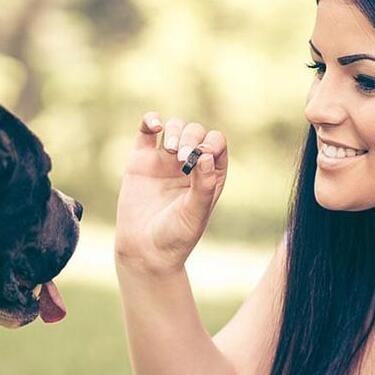
Proper nutrition for your pregnant or nursing dog is vital to her and her puppy's health. Learn what you should do provide her with the proper nutrients.
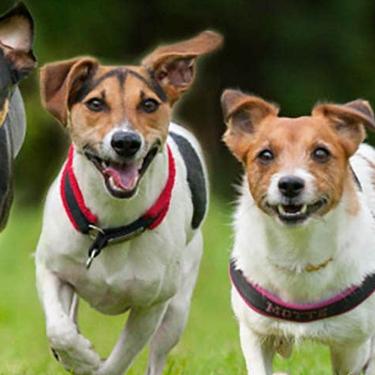
Understand the role that Omega-6 and Omega-3 fatty acids play in your dog's overall health, and how you can ensure they are getting enough.
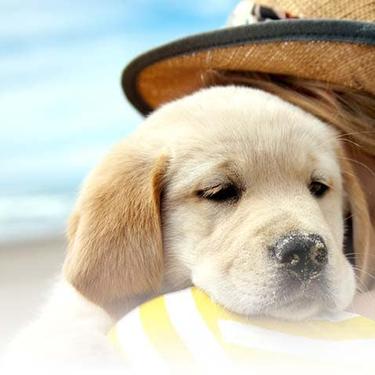
Large and giant breed puppies have different nutritional needs than other dogs. Learn how to provide the special care they need to grow up big and strong.

Learn about Hill's puppy food and the nutritional benefit & high quality ingredients that it contains for your pup.
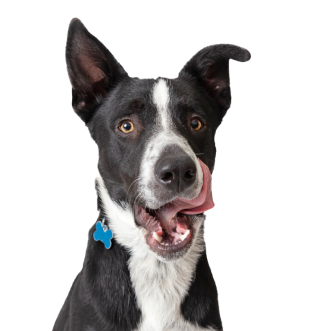
Put your dog on a diet without them knowing
Our low calorie formula helps you control your dog's weight. It's packed with high-quality protein for building lean muscles, and made with purposeful ingredients for a flavorful, nutritious meal. Clinically proven antioxidants, Vitamin C+E, help promote a healthy immune system.
Put your dog on a diet without them knowing
Our low calorie formula helps you control your dog's weight. It's packed with high-quality protein for building lean muscles, and made with purposeful ingredients for a flavorful, nutritious meal. Clinically proven antioxidants, Vitamin C+E, help promote a healthy immune system.

